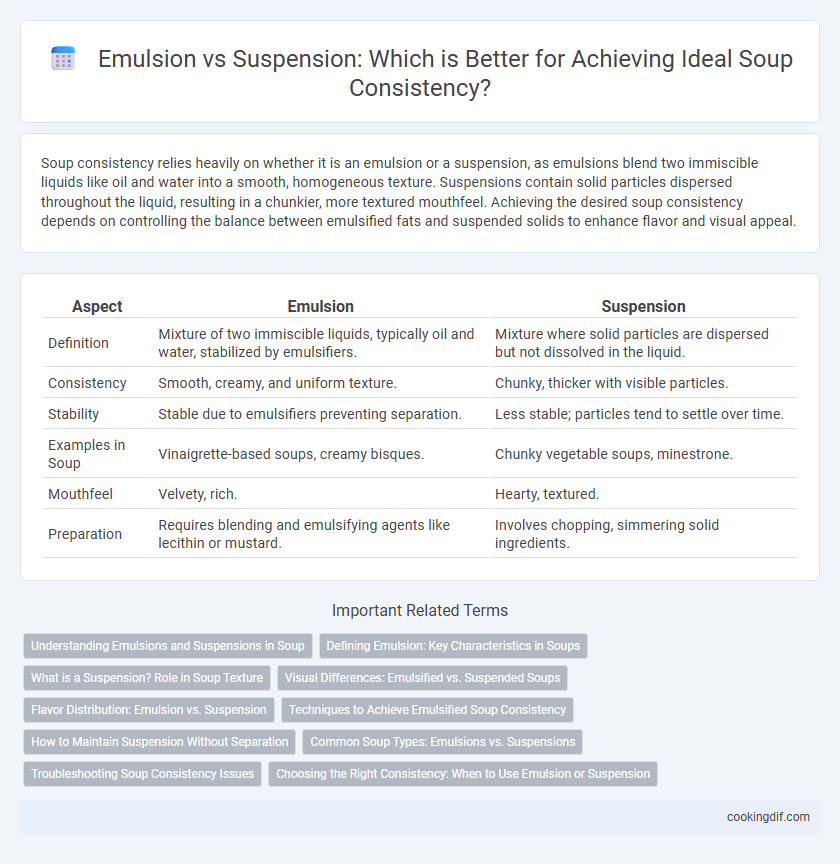Soup consistency relies heavily on whether it is an emulsion or a suspension, as emulsions blend two immiscible liquids like oil and water into a smooth, homogeneous texture. Suspensions contain solid particles dispersed throughout the liquid, resulting in a chunkier, more textured mouthfeel. Achieving the desired soup consistency depends on controlling the balance between emulsified fats and suspended solids to enhance flavor and visual appeal.
Table of Comparison
| Aspect | Emulsion | Suspension |
|---|---|---|
| Definition | Mixture of two immiscible liquids, typically oil and water, stabilized by emulsifiers. | Mixture where solid particles are dispersed but not dissolved in the liquid. |
| Consistency | Smooth, creamy, and uniform texture. | Chunky, thicker with visible particles. |
| Stability | Stable due to emulsifiers preventing separation. | Less stable; particles tend to settle over time. |
| Examples in Soup | Vinaigrette-based soups, creamy bisques. | Chunky vegetable soups, minestrone. |
| Mouthfeel | Velvety, rich. | Hearty, textured. |
| Preparation | Requires blending and emulsifying agents like lecithin or mustard. | Involves chopping, simmering solid ingredients. |
Understanding Emulsions and Suspensions in Soup
Emulsions in soup are mixtures where oil droplets are finely dispersed in water, creating a smooth and creamy texture essential for creamy soups like bisques or chowders. Suspensions contain larger particles suspended in liquid, giving a cloudier appearance and a chunkier mouthfeel typical of vegetable or lentil soups. Understanding the stability of emulsions versus the heterogeneity of suspensions helps chefs manipulate soup consistency for desired sensory and visual appeal.
Defining Emulsion: Key Characteristics in Soups
An emulsion in soups is a stable mixture where tiny droplets of fat are uniformly dispersed throughout a liquid base, creating a smooth and creamy texture. Key characteristics include uniformity, stability against separation, and a glossy appearance, often achieved by vigorous blending or using emulsifying agents like lecithin or mustard. Unlike suspensions, emulsions provide consistent mouthfeel and enhanced flavor integration, making them essential for velvety soups such as bisques and cream-based varieties.
What is a Suspension? Role in Soup Texture
A suspension in soup consists of solid particles dispersed throughout a liquid but not dissolved, creating a heterogeneous mixture that influences the soup's mouthfeel and visual appeal. These undissolved particles settle over time, requiring stirring to redistribute flavors and maintain a consistent texture. Suspensions contribute to a thicker, chunkier soup consistency, enhancing the perception of heartiness and substance.
Visual Differences: Emulsified vs. Suspended Soups
Emulsified soups, like bisques or creamy chowders, exhibit a uniform, smooth texture with a consistent color and no visible separation of liquids, giving them a glossy, homogeneous appearance. Suspended soups, such as chunky vegetable or lentil soups, display distinct particles or ingredients floating in the broth, resulting in a visibly heterogeneous and textured surface. The stability of emulsions prevents ingredient settling, while suspensions rely on the physical presence of solid components to define the soup's visual complexity.
Flavor Distribution: Emulsion vs. Suspension
Emulsion in soups creates a uniform flavor distribution by blending oil and water phases into a stable mixture, ensuring each spoonful has consistent taste and texture. In contrast, suspension relies on solid particles dispersed in liquid, which can lead to uneven flavor pockets as ingredients settle over time. Emulsified soups maintain smoothness and enhanced mouthfeel, while suspensions often require stirring to redistribute flavors evenly.
Techniques to Achieve Emulsified Soup Consistency
Achieving an emulsified soup consistency involves techniques such as slowly whisking oil or fat into a hot broth while continuously blending to create a stable mixture of fat droplets suspended in liquid. Using emulsifiers like lecithin from egg yolks or mustard can enhance stability by reducing surface tension between fat and water phases. Incorporating high-speed blenders or immersion blenders further refines texture by breaking down particles and evenly dispersing fat throughout the soup.
How to Maintain Suspension Without Separation
Maintaining suspension in soup without separation relies on selecting appropriate thickening agents like xanthan gum or guar gum, which stabilize particles uniformly throughout the liquid. Consistent stirring and controlled temperature help prevent the heavier ingredients from settling at the bottom. Particle size reduction through blending also enhances the even distribution, ensuring a smooth, cohesive soup consistency.
Common Soup Types: Emulsions vs. Suspensions
Emulsions in soups, such as bisques and creamy tomato, feature finely blended mixtures of oil and water-based ingredients, creating a smooth, homogenous texture ideal for rich, velvety consistency. Suspensions, common in chunky vegetable or chicken noodle soups, contain larger particles like vegetables, meats, or grains that remain dispersed without fully dissolving, resulting in a textured and hearty mouthfeel. Understanding these differences helps chefs achieve desired soup consistencies by selecting appropriate thickening and blending techniques according to whether an emulsion or suspension is preferred.
Troubleshooting Soup Consistency Issues
Emulsions create a smooth, homogeneous soup texture by evenly dispersing fat droplets in water, preventing separation and providing a creamy mouthfeel. Suspensions contain solid particles evenly distributed but not dissolved, which can cause gritty texture or sediment if not properly stabilized. Troubleshooting involves adjusting emulsifiers like lecithin or blending techniques to maintain stability and enhance soup consistency.
Choosing the Right Consistency: When to Use Emulsion or Suspension
Choosing the right consistency in soup involves understanding the difference between emulsions and suspensions. Emulsions create a smooth, creamy texture by blending immiscible liquids like oil and water, ideal for creamy or bisque-style soups. Suspensions maintain small solid particles dispersed throughout the liquid, providing a chunkier texture perfect for vegetable or meat-based soups where visual and textural contrast is desired.
Emulsion vs Suspension for soup consistency Infographic

 cookingdif.com
cookingdif.com